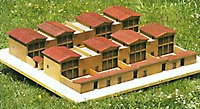
A classical city-state did not resemble a large metropolis of
the Hellenistic or Roman world. The population of Athens, the
largest of the city-states, was never more than fifty thousand. A
decisive contribution to the change in the layout of the
Classical city was made by an architect from Miletus
called Hippodamus. For the roots of the causes that led to the
evolution of a different town planning model, we must look to the
differentiation of social structures and state institutions.
Once a large number of the citizens took part in public affairs,
there was an immediate need for public buildings to hold meetings
in and to accommodate administrative services and dignitaries.
These buildings took on sizable dimensions in the town centres.
In cases like that of Athens, they became model administrative
complexes. As for private dwellings, the andron (men's
quarters) - the area where the symposium
took place - acquired special importance. For it was there that
discussions about public business went on. Most newly-built
cities and most newly-built districts of older cities followed
Hippodamos' system. This system comprised not only layout of
housing in rectangular blocks, but serial construction of
'standard' dwellings.

Athens was badly knocked about in the Persian wars.
Themistocles had already in 479 B.C. seen to new
fortifications for the city and its port. Other public
buildings, however, and particularly temples, were not
rebuilt. This was so as to keep Persian sacrilege fresh
in people's minds. In the middle years of the century,
nevertheless, Pericles went ahead with rebuilding
temples, not all of which were as splendid as those on
the Acropolis. By another modification of the city plan
of Athens, the town marketplace was transferred westwards
from its previous site north-east of the Acropolis, to a
much more spacious site going all the way up to the hill
of Colonos-in-the-Agora. The city's central axis was
the road running from the Dipylon Gate and the
Pompeum, up between the stoas and public buildings,
through the middle of both the new Agora and its
predecessor, and finishing at the Street of the Tripods.
This avenue was embellished with fountains, monuments,
altars, and statues.
The effect was one of brilliance and grandeur. This civic
ostentation contrasted with the relative simplicity, for
many years, of private dwellings. |
 |
Public feeling was significantly altered by the events of the
Peloponnesian war. Private displays of wealth became a more
common phenomenon. The houses of the well-to-do were, both in
this period and in the 4th century, composed round a
central court framed by columns. In certain cases there was a
whole wing reserved for symposia and feasts.
 |
The Piraeus owed its organization and town plan to
Hippodamus of Miletus; and for this he was held
in special esteem by its inhabitants. The plan combined
eight 'standard' dwellings, each of 250 square metres,
into a unified block of buildings. The houses had a large
courtyard with two small rooms on one side of it and two
halls on the other. One of these halls, the andron,
was larger than the other, and spacious enough to
accommodate seven reclining couches. These houses also
had an upper storey, where the thalamos (bedroom)
must surely have been. |
Roadbuilding, gateways and port connections in the Piraeus
obviously required a functional planning scheme right from the
very start. Functionality of this sort, which can be seen from
the choice of site for the Agora, seems to have been a prime
consideration for architects, even in the 4th century.
One very typical instance is the Arsenal attributed to the
architect Philon. To build the theatres of the Piraeus, natural
contours were exploited, just as at Athens. And once again,
elevated sites were chosen for temples - the temple of Artemis on
the Mounichia hill is one example - so that they could be
conspicuous from every point.
Many other Classical cities followed the system of Hippodamos:
most notably Miletus, Olynthus, Priene
and Rhodes.






